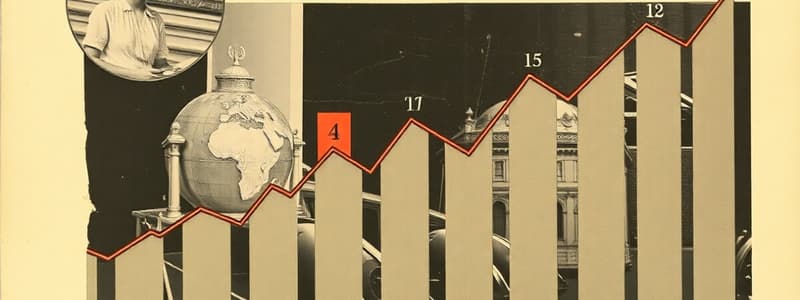Podcast
Questions and Answers
What is the primary measurement used to gauge the average price change of consumer goods and services over time?
What is the primary measurement used to gauge the average price change of consumer goods and services over time?
- Consumer Price Index (CPI) (correct)
- Producer Price Index (PPI)
- Employment Cost Index (ECI)
- Gross Domestic Product (GDP)
What type of inflation occurs when the demand for goods and services exceeds their supply?
What type of inflation occurs when the demand for goods and services exceeds their supply?
- Cost-Push Inflation
- Built-In Inflation
- Demand-Pull Inflation (correct)
- Deflationary Inflation
Which of the following factors is NOT typically associated with influencing inflation?
Which of the following factors is NOT typically associated with influencing inflation?
- Monetary Policy
- Technological Advancements (correct)
- Global Events
- Fiscal Policy
What is a consequence of hyperinflation?
What is a consequence of hyperinflation?
Which monetary policy action is typically used to combat high inflation?
Which monetary policy action is typically used to combat high inflation?
Which recent development contributed to inflation spikes after the pandemic?
Which recent development contributed to inflation spikes after the pandemic?
What is built-in inflation linked to?
What is built-in inflation linked to?
What do econometric models use to forecast future inflation?
What do econometric models use to forecast future inflation?
Flashcards are hidden until you start studying
Study Notes
Inflation Trends
-
Definition of Inflation:
- The rate at which the general level of prices for goods and services rises, resulting in decreased purchasing power.
-
Measurement of Inflation:
- Commonly measured using the Consumer Price Index (CPI) and Producer Price Index (PPI).
- CPI reflects the average price change over time of a basket of consumer goods and services.
-
Types of Inflation:
- Demand-Pull Inflation: Occurs when demand for goods and services exceeds supply.
- Cost-Push Inflation: Results from rising costs of production, leading to decreased supply.
- Built-In Inflation: Linked to adaptive expectations, such as wage-price spirals.
-
Recent Trends:
- Post-pandemic recovery led to increased demand and supply chain disruptions, contributing to inflation spikes.
- Transition from a deflationary period during the COVID-19 pandemic to inflation resurgence in various economies.
-
Global Inflation Rates:
- Differ across countries; developed nations often have lower inflation rates compared to developing countries.
- Central banks monitor these rates closely to adjust monetary policies.
-
Factors Influencing Inflation:
- Monetary Policy: Interest rates and money supply adjustments by central banks impact inflation levels.
- Fiscal Policy: Government spending and tax policies can influence demand, thus affecting inflation.
- Global Events: Oil price shocks, geopolitical tensions, and pandemics alter supply chains impacting prices.
-
Consequences of Inflation:
- High Inflation: Erodes purchasing power, leads to uncertainty, can impact savings and investments.
- Hyperinflation: Extreme case results in a rapid and uncontrolled rise in prices, typically leads to currency collapse.
-
Policy Responses:
- Interest Rate Adjustments: Increasing rates to cool down demand.
- Quantitative Tightening: Reducing the amount of money in circulation to curb inflation.
- Supply-Side Policies: Enhance productivity and supply chain efficiency to reduce cost-push inflation.
-
Forecasting Inflation:
- Economic indicators such as employment rates, wage growth, and commodity prices help predict inflation trends.
- Econometric models project future inflation based on historical data and current economic conditions.
Inflation Definition
- Inflation is the sustained increase in the general price level of goods and services.
- It results in a decrease in the purchasing power of money.
Measuring Inflation
- The Consumer Price Index (CPI) and Producer Price Index (PPI) are commonly used to measure inflation.
- CPI tracks the average price changes of a basket of consumer goods and services over time.
Types of Inflation
- Demand-pull inflation: Occurs when demand for goods and services outpaces supply.
- Cost-push inflation: Caused by rising production costs, leading to reduced supply.
- Built-in inflation: Arises due to adaptive expectations, such as wage-price spirals.
Recent Inflation Trends
- The post-pandemic recovery saw increased demand and supply chain disruptions, driving inflation spikes.
- Many economies transitioned from deflation during the pandemic to inflation.
Global Inflation Rates
- Inflation rates differ between countries.
- Developed nations tend to have lower inflation than developing countries.
- Central banks monitor inflation rates closely to adjust monetary policies.
Factors Influencing Inflation
- Monetary policy: Central bank actions like adjusting interest rates and money supply impact inflation levels.
- Fiscal policy: Government spending and tax policies influence demand, thus affecting inflation.
- Global events: Events like oil price shocks, geopolitical tensions, and pandemics disrupt supply chains, impacting prices.
Consequences of Inflation
- High inflation: Erodes purchasing power, increases uncertainty, impacts savings and investments.
- Hyperinflation: An extreme case of inflation where prices rise rapidly and uncontrollably, potentially leading to currency collapse.
Policy Responses to Inflation
- Interest rate adjustments: Raising interest rates can cool down demand.
- Quantitative tightening: Reducing the money supply in circulation to curb inflation.
- Supply-side policies: Policies to enhance productivity and supply chain efficiency reduce cost-push inflation.
Forecasting Inflation
- Economic indicators like employment rates, wage growth, and commodity prices help to predict inflation trends.
- Econometric models utilize historical data and current economic conditions to project future inflation.
Studying That Suits You
Use AI to generate personalized quizzes and flashcards to suit your learning preferences.




